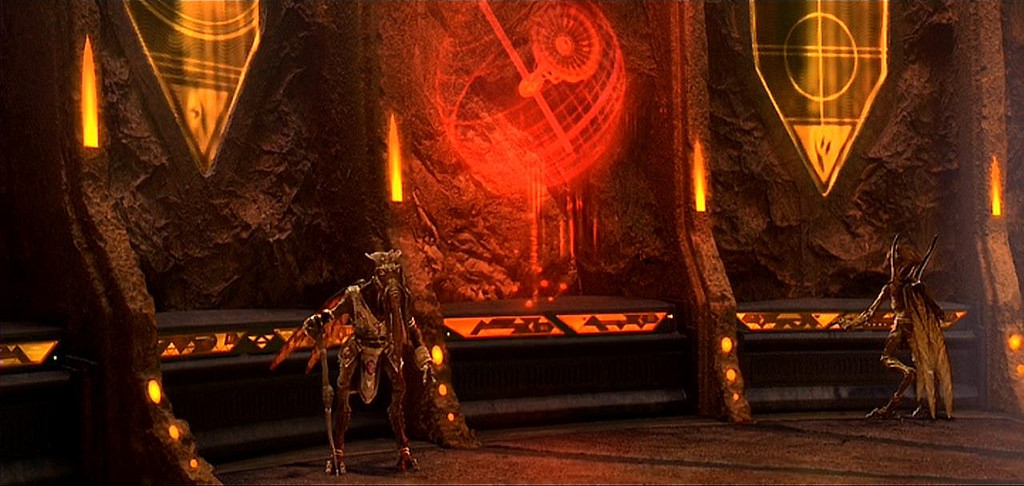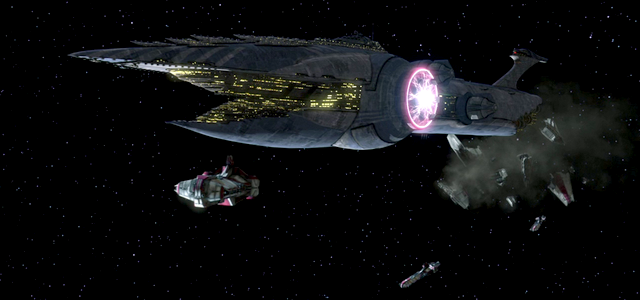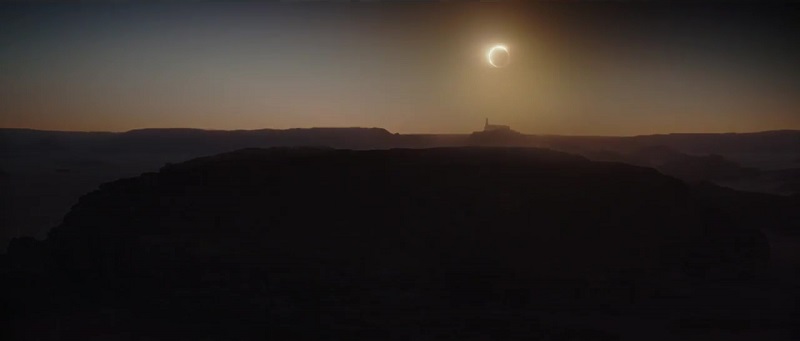
Wait, I thought Rogue One was in the era of the Empire and all the good stuff, that it had nothing to do with the prequels? You may have thought that but it does not look to be so. For there is a prequel novel, Catalyst, which recently had a killer blurb come out:
War is tearing the galaxy apart. For years the Republic and the Separatists have battled across the stars, each building more and more deadly technology in an attempt to win the war. As a member of Chancellor Palpatine’s top secret Death Star project, Orson Krennic is determined to develop a superweapon before their enemies can. And an old friend of Krennic’s, the brilliant scientist Galen Erso, could be the key.
Galen’s energy-focused research has captured the attention of both Krennic and his foes, making the scientist a crucial pawn in the galactic conflict. But after Krennic rescues Galen, his wife, Lyra, and their young daughter, Jyn, from Separatist kidnappers, the Erso family is deeply in Krennic’s debt. Krennic then offers Galen an extraordinary opportunity: to continue his scientific studies with every resource put utterly at his disposal. While Galen and Lyra believe that his energy research will be used purely in altruistic ways, Krennic has other plans that will finally make the Death Star a reality. Trapped in their benefactor’s tightening grasp, the Ersos must untangle Krennic’s web of deception to save themselves and the galaxy itself.
After Revenge of the Sith in 2005, I thought we might get stories that drew on all six films, that the division between the trilogies might start to fade. It never happened. Oh, there were a couple of exceptions that really tried to make the most of the prequels – series like the Legacy comics, actually DHC really did try. On the whole? Nope. And we look to be heading for similar divided territory with the start of the sequel trilogy.
At the time it looked quite nuts – Lucas decided to have the Death Star plans turn up in the hands of the Geonosians, why? Because he wanted them to. Certainly the depiction of the Clone Wars from 2002-2005 showed little to warrant developing a Death Star, The Clone Wars 2008-2013 however…. Oh yes, I am far from finished watching the lot, but it is clearly a portrait of a far more destructive war than before, including superweapon development from the start with the Malevolence’s ion cannon.

This means the Clone Wars become considerably more than they were before and I greatly liked their prior status. That status being that they were to destroy the Jedi, on multiple levels, and gradually get the galaxy used to a militaristic, Imperial model of thinking. The result of this is that by the time of ROTS, the declaration of Empire is little more than a formality. What tended to be the case post-2005 is that a Jedi would spring up somewhere, Vader would kill it, rinse and repeat. That there were a handful of Jedi survivors made for a useful fiction for the retention of emergency powers, for the continuation of the Empire. What the new version of the Clone Wars suggests is that there was something far better for Sidious to accomplish this end – the Clone Wars themselves as the ultimate spectre.
Nor is this without precedent in the new material – fear is not something we are used to seeing in the likes of Grand Moff Tarkin. Yet, like Krennic, the Clone Wars haunts him. In the minds of Krennic and Tarkin, nothing matters more than security and the only way to get security is through force. The more force applied, the better the results. An orbital bombardment by a Star Destroyer may terrify a planet for a time, but not for all time. No, something more, something bigger is needed, thus the Death Star. In effect, this renders the Clone Wars as something far worse, a trap set not just for the Jedi, but for the Senate and the galaxy. To encourage them to not only willingly enter into totalitarianism but to also build the tools to maintain it forever.
One of the things that Legends’ depiction of the Empire was known for was showing why officers stayed with it, even after the destruction of Alderaan. The new material, in contrast, has been more brutal in how the Empire operates. What Catalyst suggests is there might be reason for this, at least in the minds of the officers. Sure, they bombed the droid factories, attacked the manufacturing facilties and shipyards but the Separatists were forever rebuilding and repairing. It was a constant war of attrition of who could hit the other hardest while churning out greater material resources, be they droids or clones. How many of the officers who fought through the Clone Wars concluded there must be a better way to deal with this? That if they had a weapon that could wipe out the enemy resources so completely no repair or rebuilding was possible, would that not be better?
In this light, the Death Star becomes not only a necessary, but even a desirable idea! If the Death Star had existed before the Clone Wars, its very presence would have quelled their rebellion. Trillions of beings would not have been killed in the galactic conflagration of the Clone Wars, the clones would not have been fed into numerous meat-grinder ground battles across the galaxy…how could anyone not like the idea?
At the same time, the fledgling rebellion we first see taking shape in Tarkin and Rebels is going to look like only one thing to some Clone Wars veterans: Separatism reborn! In order to avoid a repeat of that horror, anything is justified. This is the inverse of the attitude of many British politicians in the later inter-war years. These were men who had seen the terrifying destruction of World War I and its terrible bloodbath casualties and deaths. To them, as reasoned, educated men it would be unthinkable that anyone would wish to return to that. (Indeed, it might be that the same attitude arose among the older generation after the Galactic Civil War, that only a psychopath or a fool would wish to return to war.) Where they were inclined to do anything to avoid a war without starting one, to Krennic and Tarkin it is likely to be the opposite. To avoid a greater war, the smaller ones have to be won totally.

This also links into another theme of the new material which is the seductiveness of the Empire, that it may be brutal but its brutality is needed – that was the case for Sloane and probably many others. (It is worth noting at this point the Empire’s wannabe descendant, the First Order, has nowhere near anything approaching the Clone Wars in terms of compelling reasons for being.)
All of this plays right into Sidious’s hands by giving him all he requires to keep his regime running, with an army of wiling followers. With the twin spectres of both Jedi and Clone Wars conjured, he can lay claim to all the moral justification he needs to deal with the Senate – at least until the Death Star is operational. Those twin spectres also act to banish any sense of doubt or questioning, especially as to how the Clone Wars came about. True, most of those involved save Sidious are dead, but you never know what someone might have left behind, better by far to ensure the questions are never asked in the first place. The twin threats also tend to direct perception away from such questions towards the correct solution of the Empire.
With all this in mind, what I’m hoping for with Catalyst is a book that connects the two eras in a far more concrete way than anything done previously. That it starts to break down the barriers by showing that one of the icons of the films, the Death Star, couldn’t truly exist without the Clone Wars. At the same time it can also raise the counter question as to whether anything, even a galactic cataclysm on the level of the Clone Wars, can justify going to the extremes embodied by the Death Star. Will I get this? I’ll find out in November.

Good article. I would disagree that the First Order “has nowhere near anything approaching the Clone Wars in terms of compelling reasons for being.” If anything, the destruction of the Empire and the old order by the Rebellion and the emergence of the New Republic is everything that the old Imperials who went through the Clone Wars feared. Reading the new canon material, it put what they considered terrorists into power and at the same time created a power vacuum since the military was disbanded and Senators went back to squabbling and creating gridlock (democracy). It remains to be seen if the fanaticism that we’ve seen in both Hux and Kylo Ren extends to the rest of the First Order, but it’s interesting that all the officers seen in the First Awakens were so young. They’re a small group (from what we’ve seen so far) but also indoctrinated, since they grew up with these stories, and that makes them even more potentially dangerous than a career officer who grew up in the Republic, fought in the Clone Wars, and transitioned to serving in the Empire.
In a way I suppose it depends what you find compelling but that’s highly subjective.
Regardless, the way you sketch out the legacy element of the First Order is something I hadn’t considered. The source of their info on the nature of the galaxy is likely all from Brendol Hux too.